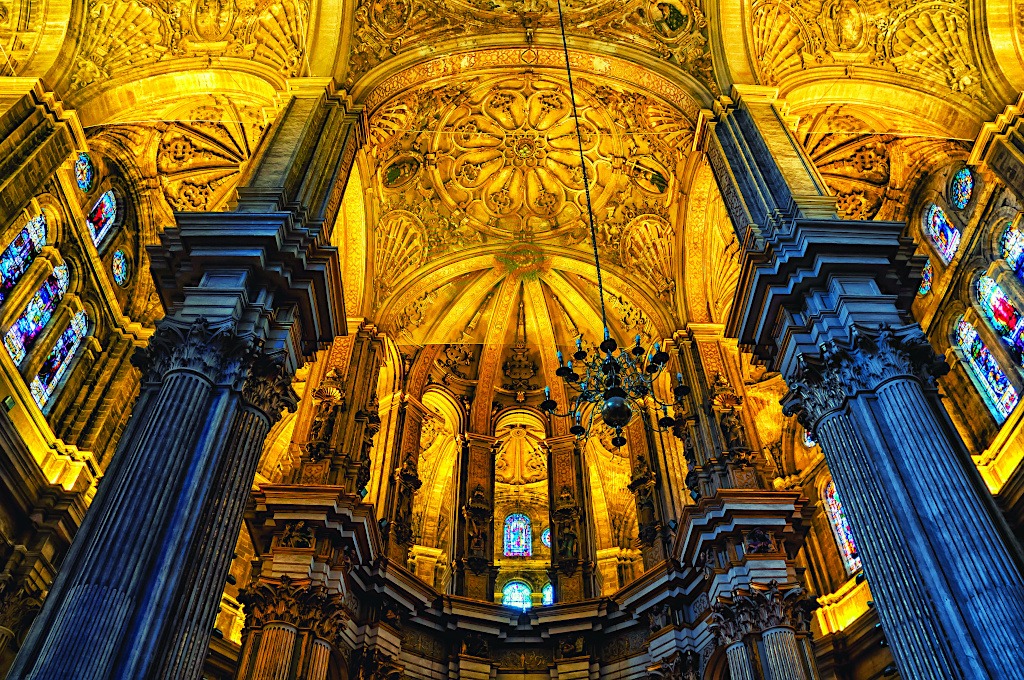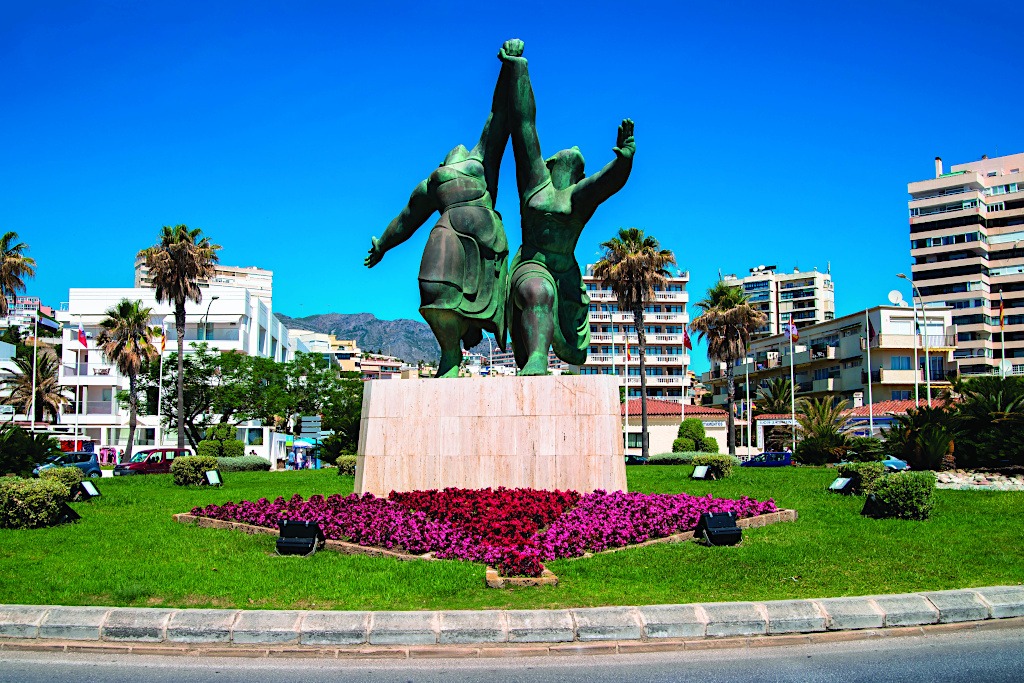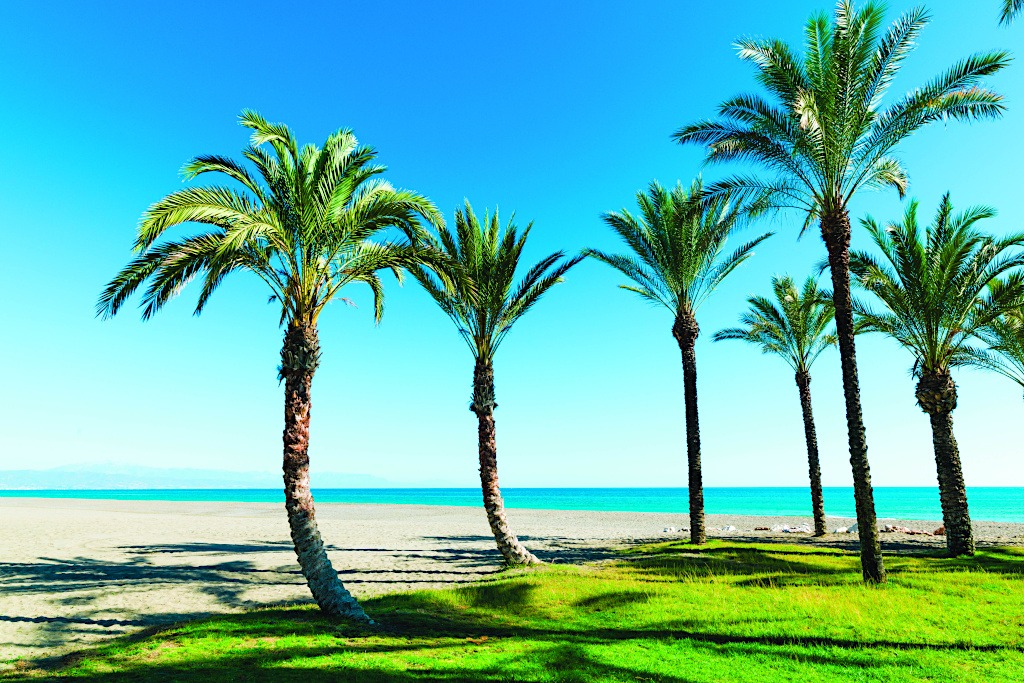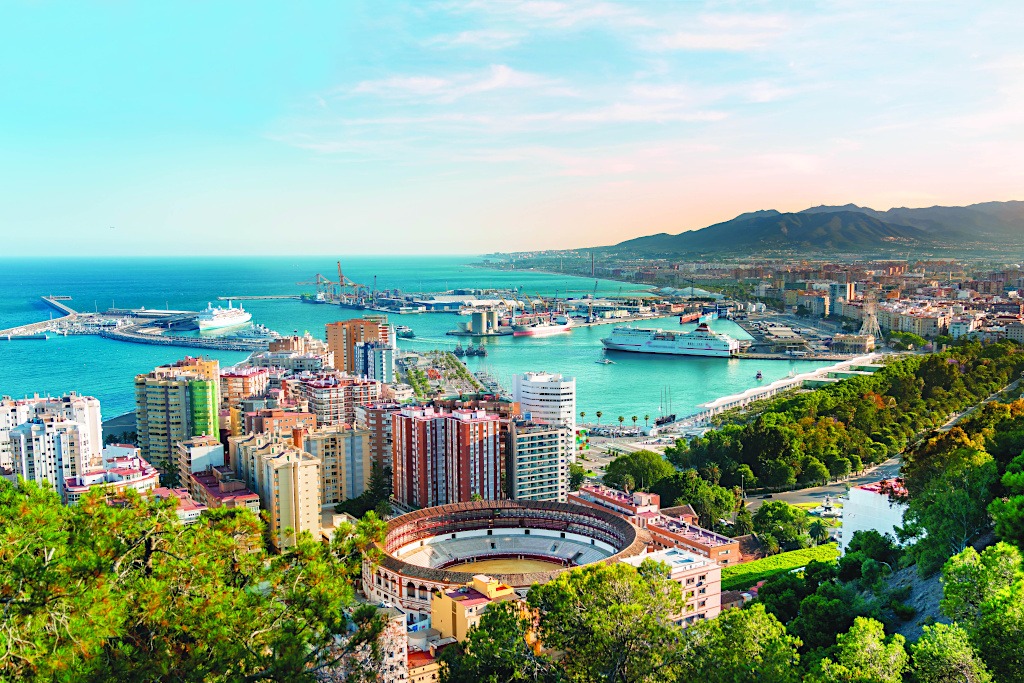Much of Málaga’s historical center is a pedestrian zone, so the marble-paved streets and shady alleyways are a pleasure to explore on foot. Tucked away in the backstreets are many bodegas, ideal for sampling a glass of sweet Málaga Virgen wine or a bite or two of tapas.
Named after the local youths who once loitered around Málaga’s docks in days of old, helping ships to unload their cargo or directing sailors to brothels and other illicit pleasures, El Pimpi is probably Málaga’s most iconic bodega. This rambling warren of rooms is decorated with old posters of bullfights and ferias, as well as photographs of well-known customers. Enormous old barrels also bear the signatures and endorsements of El Pimpi’s most famous patrons, including Antonio Banderas, Paloma Picasso, Carmen Thyssen, and former British PM Tony Blair. Grab a stool and embrace the bustle and atmosphere, or take a table on the large outdoor terrace for a more relaxed ambience.

Interior of the Cathedral in Málaga
Photo: Madrugada Verde
For a modern reinvention of the classic bodega, try Taberna Uvedoble. It’s a small, sleek space with clean lines and modern art. Each dish comes in three sizes (tapa, media, entera) so you can mix-and-match. Menu highlights include bluefin tuna with cauliflower emulsion, black squid ink fideos with baby calamari, and suckling piglet brioche with aioli.
Although Málaga is justifiably proud of its arty attractions, the city also boasts a strong and significant historical backbone. This includes the recently excavated Roman theatre dating from the first century BC, as well as the medieval Alcazaba palace and Gibralfaro castle.
Built in the early 11th century, the Alcazaba is an impressive fortress palace standing in the heart of Málaga. Located atop a hill, its strategic position is further reinforced by a double layer of walls, massive entry fortifications, and narrow windows where archers would wait with arrows poised. Unexpected visitors were clearly not welcome here in medieval times!
Beyond these impenetrable battlements is a Moorish palace arranged around a series of tranquil Andalusían patios, complete with gardens and reflecting pools. The layout and architectural style is reminiscent of the world-renowned Alhambra palace complex in nearby Granada, making this a fascinating and picturesque place to visit.
Farther up from here, on the very top of the hill, is the striking Castillo de Gibralfaro. Dating from the 10th century, visitors may walk entirely around the restored ramparts, giving a real sense of the castle’s strategically important position. The castle was famously besieged in 1487 during the Reconquest of Spain, when the Catholic monarchs King Ferdinand and Queen Isabella conquered Málaga from the Moors (the Arab Muslims who had ruled this territory, then known as al-Andalus, for centuries). The castle resisted the siege for 3 months and ended not because of gunpowder or military might, but because hunger forced those inside to surrender. As a punishment to the citizens of Málaga for their prolonged resistance, King Ferdinand condemned them all to slavery or death.
In 1526, work began on constructing Málaga cathedral on the foundations of the old mosque. This wonderfully ornate landmark is nicknamed La Manaquita (the one-armed lady), because it has just a single tower. Work on the south tower was never finished, with a plaque explaining that the funds raised to complete it were instead donated to what became the United States, to help gain their independence from Great Britain, although parish records dispute this claim.

Picasso Sculpture in Torremolinos
Photo: Konwicki Marcin
Despite its size and artistic persuasions, one thing that Málaga lacks is a significant LGBT scene. A quick peek at Grindr or Scruff will show that there is a considerable gay population hereabouts, yet the city has just a handful of gay-frequented venues such as El Carmen, a friendly little café-bar with an outdoor terrace on Plaza de la Merced, just a splash of paint away from Picasso’s birthplace.
This isn’t because gay and lesbian malagueños don’t like to party. It’s because one of Europe’s favorite gay destinations is located a short distance along the coast, and that’s where they go to sunbathe, socialize, and have fun in the sun.
Just 30 minutes away by train is the resort town of Torremolinos. Like many similar places along the Costa del Sol, what was once a poor and insignificant little fishing village saw its fortunes reversed when tourism began to boom here in the late 1950s. Torremolinos rapidly developed into one of Spain’s biggest and best-known resorts. Although many now frown at Torremolinos, favoring more exclusive vacation spots like Marbella and Puerto Banus, it remains popular with northern Europeans and has a large British expatriate population.
It also has a booming gay scene. Located right on Bajondillo beach in the heart of Torremolinos is Eden Beach Club. A set of rainbow colored steps lead to this popular gay beach bar and chiringuito. Rent a sunbed and a parasol and enjoy the handsome local scenery. Located on the beachfront promenade overlooking the gay beach, El Gato Lounge is another recommended daytime choice.
Just a few steps away is the 4-star Meliá Costa del Sol. Considered the leading hotel in Torremolinos, amenities include two swimming pools and a Thalasso Marine Spa. The 540 rooms and suites have sleek, modern decor and all have private terraces with direct sea views. For extra indulgence, stay on The Level and enjoy privileged access to VIP areas within the hotel as well as complementary drinks, aperitifs, wine, and snacks.
LGBT visitors may instead prefer the Hotel Ritual. Open since 2017, this adults-only hotel has 138 rooms, and targets a predominantly gay and lesbian clientele with facilities such as a clothing-optional rooftop with bar and infinity pool.

Navajas House in Torremolinos
Photo: Pabkov
After dark, the pretty whitewashed alleyways of the Pueblo Blanco area are a good place to enjoy dinner or a cocktail. From 11 P.M. onwards, head across the street to the La Nogalera area, where venue upon venue cater to the full gay spectrum, including small and intimate drinking dens, outrageously camp show bars, cruise clubs with darkrooms, and raving all-night dance clubs.
Popular gay bars include Codigo, Eden Copas, and Ritual Copas, all of which have adjoining outdoor terraces making them perfect for socializing and people watching. Many have drag shows, although you may need a translator if you don’t speak Spanish. Venues such as Men’s Bar and Free Eagle cater to the bear, leather, and fetish fraternities. Open since 1996, Parthenon remains a popular gay dance club, attracting a predominantly younger local crowd. New state-of-the-art venues such as Aqua and Centuryon host regular special events and circuit parties such as Madrid’s WE Party and Mad Bear Beach festival, French circuit event Delice Dream, and Fetish Week. Not to forget Torremolinos Gay Pride, held annually at the end of May.
Although busiest at weekends, especially during the peak summer months, the majority of gay venues are open from March to October, with some remaining open throughout the year.

Playa de la Carihuela,Torremolinos
Photo: colorsphotostock
Continue further along the coast, and you’ll discover one of the regions most picturesque and popular gay nudist beaches. Backed by the Dunas de Artola, a protected nature reserve, Playa de Cabopino occupies one of the few remaining undeveloped stretches of coastline. This stunning beach offers a rare chance to enjoy tranquillity, freedom, nature, and naturism on the Costa del Sol. The gay section is on the western sweep of the beach, close to Restaurante Triana, a beachside chiringuito.
More readily accessible from both Málaga and Torremolinos is another gay nude beach, Playa de Guadalmar. This beach is also secluded with very little development nearby, but that’s because it’s directly below the flight path to Málaga airport. In spite of the roar of jet engines overhead, it’s a popular spot for nude sunbathing as well as cruising. There’s also car cruising at night in the adjacent car park.
All you need to consider is where to start: Málaga or Torremolinos? If you can’t decide, you can always flip a coin!


